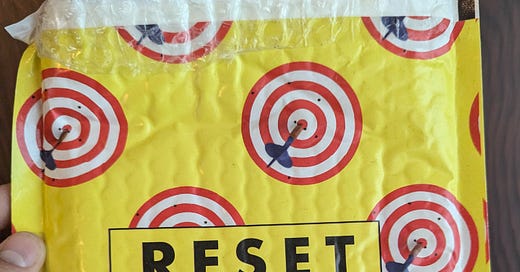On September 15th, my life changed forever. It started the way most life-changing moments do: with a sponsored LinkedIn message. This one was from the notoriously sticky Dan Heath. He wanted to send me a free copy of his upcoming book Reset, in hopes that I would write about it. That’s right, it was the first time someone I didn’t know had sent me something for free because they thought other people would care about my opinion. I’m living the Millennial dream1; I’m finally an influencer! Side note: the book came in adorable custom packaging and I want everything I send or receive from now on to be wrapped in something similarly bespoke.
I felt like this was fair game for a futures newsletter for two reasons: first, having just taken an entire course on how things change (and, to a lesser extent, how to change things), it seemed well aligned; second, this was the first time I ever received a book literally from the future — the copyright is from 2025!

Heath’s thesis is that creating change in stubborn situations2 is fundamentally a two-step process: first, figure out the way in which effort can be best applied to improve the outcome; second, apply effort there. This is essentially just a restatement of what it means to be an intelligent agent: acting with intention, based on an understanding of cause and effect. However, the book’s value is in insisting that even for problems that seem intractable or hopeless, the same approach applies, and perhaps there are ways of approaching the two sides of this that you haven’t considered.
To find the leverage points, he suggests physically watching/shadowing the process to avoid thinking about it at only an abstract level; make sure you’re targeting the thing that matters and not an ancillary measure of it; study the places (inside or outside the organization) where the same problem is going well; analyze the system and see if you can find the single constraint that is causing problems (realizing that, even if there is just one, it will change as the system changes); and map the system to expose your assumptions.
To move effort to the leverage point, he proposes starting with a flashy effort that makes meaningful progress and gets people excited about continuing; find some parts of what you’re doing that are currently yielding zero or negative returns, and repurposing that time; finding the highest-value work and relentlessly prioritizing; find the overlap between what needs to be done and what specific people are intrinsically interested in doing; give teams autonomy to figure out the problems they spend all day experiencing; and create information feedback loops in the system to learn faster and do more of what’s working.
This isn’t a recipe; the idea isn’t that you have to do all or even most of these, but to give you a toolbox of strategies, some of which may help you get unstuck in a given situation that seems unique and impossible. Heath even made a helpful one-pager to go along with the book.
Is it worth your time when it comes out next month? It is a business book, for good and bad: it has the requisite number of interesting business success stories and mildly self-deprecating anecdotes to seem relatable and folksy, it’s written in the most straightforward and harmless English this side of LinkedIn, and it clocks in at just about 200 (admittedly breezy) pages. If you find that overly aversive, there’s not enough here to redeem the book. But if you’re a leader or otherwise a thinking member of complex human systems that fall short of their potential, it might be a helpful way to take a step back and methodically seek solutions.
Bonus Content: Fall Guy
I was on a plane last night and decided that this year’s Ryan Gosling / Emily Blunt commercial failure Fall Guy would be exactly the kind of no-stakes watch that I could watch and be fine if the flight ended with 10 minutes left in it3. It was fine? I was definitely not expecting that the main character being a stunt man meant that he essentially had superpowers to do whatever ridiculous feat was required in real life, but if you read the film as a self-aware showcase of / love letter to the people in Hollywood stunt crews who make action movies possible by putting their bodies on the line day after day, it is at least coherent.
However, I was surprised that a key part of the plot revolves around 3D scanning of actors, AI deepfakes, and how the combination of the two may lead to a chaotic future where videos circulating show things that didn’t actually happen - I call this “truth collapse”. Not enough to make the movie count as intellectually enriching on balance, but I was pleasantly surprised to see some plausible near-term futures explored.
For the record, I don’t identify as Millennial. They’ve moved the goalposts a couple of times on that generation, but I remember when it was defined as the kids that graduated high school after 9/11, and I graduated a year early. So technically, according to my internal logic, almost everyone my age is a Millennial, but I am part of an older, more refined generation. Presumably this gives you some harrowing insight into my personality.
The kind of problems Heath has in mind are those where part or all of the system of an organization is giving an undesired result. That is, a complex system is behaving unpredictably, and so it’s not immediately obvious what to do about it. Taken this way, the book is a very thorough explanation of the “Probe-Sense-Respond” strategy for dealing with the upper-left quadrant of the Cynefin diagram.
This is exactly what happened, and I was exactly as fine as I expected.




